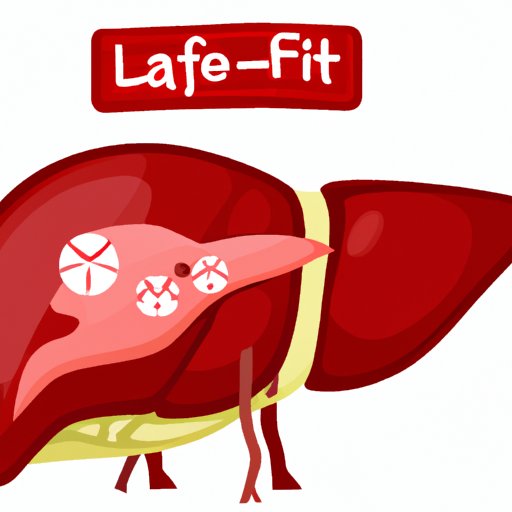
Introduction
Fatty liver is a term that describes the buildup of excess fat in the liver. This fat accumulation can cause inflammation and scarring of liver tissues, resulting in a condition known as fatty liver disease. If left untreated, fatty liver disease can cause more severe liver damage, leading to potentially life-threatening health problems such as cirrhosis and liver cancer. Therefore, preventing fatty liver disease is important for maintaining a healthy liver and overall health.
Overconsumption of Alcohol
Excessive alcohol consumption is known to be the most common cause of fatty liver disease. The liver is responsible for breaking down and metabolizing alcohol in the body. However, when alcohol is consumed in excess, the liver is not able to process it effectively. This leads to the accumulation of fat in liver cells and the development of alcoholic fatty liver disease.
Alcohol can damage liver cells over time, leading to inflammation and liver disease. Regular heavy drinking increases the risk of developing fatty liver disease and other serious health problems, including liver failure and liver cancer. It is important to note that even occasional binge drinking can contribute to the development of fatty liver disease.
The recommended safe alcohol consumption levels are up to two drinks per day for men and up to one drink per day for women.
Obesity
Nonalcoholic fatty liver disease (NAFLD) is the most common form of fatty liver disease among non-drinkers. This type of fatty liver disease is typically caused by obesity and metabolic syndrome, a cluster of conditions that includes high blood pressure, high blood sugar, and excess body fat around the waist.
Excess body weight can cause the liver to become overloaded with fat, interfering with its ability to function properly. This fatty accumulation in liver cells results in inflammation and can lead to fibrosis or even cirrhosis over time.
There are several risk factors for developing obesity and NAFLD, including eating a high-calorie diet, living a sedentary lifestyle, and having a family history of NAFLD.
Unhealthy Eating Habits
Unhealthy eating habits, such as consuming high amounts of sugars, processed, and fried foods, are another common cause of fatty liver disease. Consuming too much sugar leads to the accumulation of fat in the liver. Processed and fried foods contribute to the development of fatty liver disease due to the high levels of fat and cholesterol they contain.
A healthy diet is an important part of preventing and treating fatty liver disease. Eating a diet rich in vegetables, fruits, whole grains, and lean protein sources can help reduce the risk of developing this condition. Foods that are high in fiber and low in calories, such as green leafy vegetables and legumes, are especially beneficial for liver health.
Insulin Resistance
Insulin resistance is another factor that contributes to the development of NAFLD. Insulin resistance occurs when the body cannot use insulin effectively, which leads to high blood sugar levels and increased fat storage in the liver. This can lead to the development of fatty liver disease.
Risk factors for insulin resistance include obesity, a sedentary lifestyle, and a diet high in sugars and refined carbohydrates. Insulin resistance can be treated and managed through regular exercise, a healthy diet, and weight loss.
Sedentary Lifestyle
A sedentary lifestyle is a well-known risk factor for metabolic imbalance and liver problems. A lack of exercise leads to the accumulation of fat in the liver, contributing to the development of fatty liver disease. Regular exercise and physical activity, on the other hand, can help reduce the risk of fatty liver disease and improve liver health.
Exercise helps improve insulin sensitivity and burns excess fat in the liver, reducing the risk of liver damage. Any type of physical activity, such as walking, jogging, or resistance training, can help improve liver health and prevent fatty liver disease.
Certain Medications
Certain medications can cause fatty liver disease as a side effect. Some commonly used medications that can cause fatty liver disease include methotrexate, corticosteroids, tamoxifen, and amiodarone. Additionally, some over-the-counter medications, such as acetaminophen, can cause liver damage if taken in large quantities or over a long period of time.
If you are taking any medications and are concerned about their effects on your liver health, consult your doctor. They can recommend alternatives and help you make lifestyle changes to reduce your risk of developing fatty liver disease.
Genetics
Genetic factors can also contribute to the development of fatty liver disease. Certain genes may increase an individual’s predisposition to developing fatty liver disease, although the role of genetics in fatty liver disease is not yet fully understood.
It is important to consider potential genetic risks and consult your doctor for personalized recommendations on preventing and treating fatty liver disease.
Conclusion
In conclusion, fatty liver disease can result from a variety of factors including alcohol consumption, obesity, unhealthy diet, insulin resistance, sedentary lifestyle, certain medications and genetics. Early detection and preventive lifestyle changes such as reducing alcohol and sugar consumption, maintaining a healthy weight, regular physical activity, and a healthy diet can cure or prevent fatty liver disease. Consult with a healthcare professional if you are concerned about your risk for fatty liver disease or its prevention.




